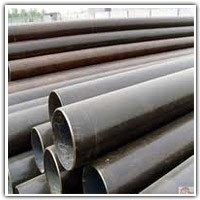UNS 32750 Dupex Stainless Steel Seamless Pipes & Tubes
 |
Super Duplex Stainless Steel is a highly alloyed, good performance Duplex steel with a pitting resistance. Super Duplex offers good resistance to pitting and crevice corrosion. Super Duplex is suited for use in aggressive environments. Super Duplex Stainless has good resistance to stress corrosion cracking in chloride and sour environments. Super Duplex has good resistance to erosion corrosion and corrosion fatigue. Super Duplex stainless like Duplex, is a mixed microstructure of austenite and ferrite (50/50) which has improved strength over ferritic and austenitic steel grades. The main difference is that Super duplex has a higher Molybdenum and Chromium content which gives the material greater corrosion resistance. Super Duplex has the same benefits as its counterpart - it has lower production costs when compared with similar ferritic and austenitic grades and due to the materials increased tensile and yield strength, in many cases this gives the purchaser the welcomed option of purchasing smaller thicknesses without the need to compromise on quality and performance. |
![]() Benefits of UNS32750 Super Duplex Stainless Steel
Benefits of UNS32750 Super Duplex Stainless Steel
-
- Improved corrosion resistance in comparison to Duplex
- Greater tensile and yield strength
- Good ductility and toughness
- Good stress corrosion cracking resistance (SSC)
- Opportunity for purchases to reduce their material costs without compromising on quality
![]() General Properties
General Properties
Alloy 2507 is a super duplex stainless steel with 25% chromium, 4% molybdenum, and 7% nickel designed for demanding applications which require exceptional strength and corrosion resistance, such as chemical process, petrochemical, and seawater equipment. The steel has excellent resistance to chloride stress corrosion cracking, high thermal conductivity and a low coefficient of thermal expansion. The high chromium, molybdenum, and nitrogen levels provide excellent resistance to pitting, crevice, and general corrosion. The impact strength is also high. Alloy 2507 is not recommended for applications which require long exposures to temperatures above 5700F because of the risk of a reduction in toughness. |
![]() Applications
Applications
-
- Oil and gas industry equipment
- Offshore platforms, heat exchangers, process and service water systems, fire-fighting systems, injection and ballast water systems
- Chemical process industries, heat exchangers, vessels, and piping
- Desalination plants, high pressure RO-plant and seawater piping
- Mechanical and structural components, high strength, corrosion-resistant parts
- Power industry FGD systems, utility and industrial scrubber systems, absorber towers, ducting, and piping
![]() Standards
Standards
| ASTM/ASME .......... A240 - UNS S32750 EURONORM............ 1.4410 - X2 Cr Ni MoN 25.7.4 AFNOR.................... Z3 CN 25.06 Az |
![]() Corrosion Resistance
Corrosion Resistance
General Corrosion Stainless steel of type 316L (2.5%Mo) cannot be used in hydrochloric acid due to the risk of localized and uniform corrosion. However, 2507 can be used in dilute hydrochloric acid. Pitting need not be a risk in the zone below the borderline in this figure, but crevices must be avoided. Isocorrosion curves, 0.1 mm/year, in hydrochloric acid. Intergranural Corrosion Crevice Corrosion |
![]() Chemical Analysis
Chemical Analysis
Typical values (Weight %)
|
|||||||||||||||||||
![]() Mechanical Properties
Mechanical Properties
Mechanical and Physical Properties 2507 combines high tensile and impact strength with a low coefficient of thermal expansion and high thermal conductivity. These properties are suitable for many structural and mechanical components. The low, ambient, and elevated temperature mechanical properties of 2507 sheet and plate are shown below. All of the test data shown are for samples in the annealed and quenched condition. 2507 is not recommended for applications which require long exposures to temperatures in excess of 5700F because of the increased risk of a reduction in toughness. The data listed here are typical for wrought products and should not be regarded as a maximum or minimum value unless specifically stated. |
![]() Mechanical Properties
Mechanical Properties
|
Low Temperature Impact Properties
|
Elevated Temperature Tensile Properties
|
![]() Physical Properties
Physical Properties
|
![]() Processing
Processing
Hot forming 2507 should be hot worked between 18750F and 22500F. This should be followed by a solution anneal at 19250F minimum and a rapid air or water quench. Cold Forming Most of the common stainless steel forming methods can be used for cold working 2507. The alloy has a higher yield strength and lower ductility than the austenitic steels so fabricators may find that higher forming forces, increased radius of bending, and increased allowance for springback are necessary. Deep drawing, stretch forming, and similar processes are more difficult to perform on 2507 than on an austenitic stainless steel. When forming requires more than 10% cold deformation, a solution anneal and quench are recommended. Heat Treatment 2507 should be solution annealed and quenched after either hot or cold forming. Solution annealing should be done at a minimum of 19250F. Annealing should be followed immediately by a rapid air or water quench. To obtain maximum corrosion resistance, heat treated products should be pickled and rinsed. |
![]() Welding
Welding
2507 possesses good weldability and can be joined to itself or other materials by shielded metal arc welding (SMAW), gas tungsten arc welding (GTAW), plasma arc welding (PAW), flux cored wire (FCW), or submerged arc welding (SAW). 2507/P100 filler metal is suggested when welding 2507 because it will produce the appropriate duplex weld structure. Preheating of 2507 is not necessary except to prevent condensation on cold metal. The interpass weld temperature should not exceed 3000F or the weld integrity can be adversely affected. The root should be shielded with argon or 90% N2/10% H2 purging gas for maximum corrosion resistance. The latter provides better corrosion resistance. If welding is to be done on only one surface and post-weld cleaning is not possible, GTAW is suggested for root passes. GTAW or PAW should not be done without a filler metal unless post-weld cleanup is possible. A heat input of 5-38 kJ/in. should be used for SMAW or GTAW. A heat input of about 50kJ/in. can be used for SAW. |
